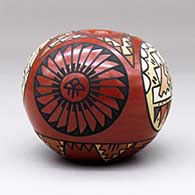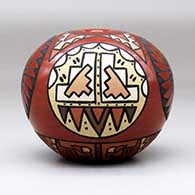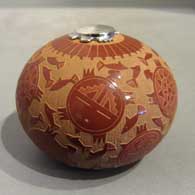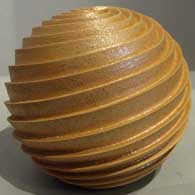
Maria Minnie Vigil
1931-2024
Santa Clara

The first child of Petra Montoya of Pojoaque and Juan Gutierrez of Santa Clara, Maria D. Minnie Vigil was born in 1931. She grew up at Santa Clara but was an enrolled member of Pojoaque Pueblo. The oldest sister of Gloria (Goldenrod) Garcia, Thelma Talachy and Lois Gutierrez de la Cruz, Minnie grew up learning the fundamentals of the traditional way of making pottery from their mother. She began making pottery for the marketplace in 1955 and won her first award at the Santa Fe Indian Market in 1975.
Minnie specialized in polychrome wares, some slipped in red clay and stone polished, some slipped in matte tan clay and not polished. Her favorite designs were rainbows, rain clouds, bear paws and sky bands.
Minnie typically signed her pieces as "Minnie, Santa Clara". She was married to Reynel Vigil and they had four children: Annette, Jeanette, Tim and Bernadette.
100 West San Francisco Street, Santa Fe, New Mexico 87501
(505) 986-1234 - www.andreafisherpottery.com - All Rights Reserved

Santa Clara Pueblo

Ruins at Puye Cliffs, Santa Clara Pueblo
Santa Clara Pueblo straddles the Rio Grande about 25 miles north of Santa Fe. Of all the pueblos, Santa Clara has the largest number of potters.
The ancestral roots of the Santa Clara people have been traced to ancient pueblos in the Mesa Verde region in southwestern Colorado. When that area began to get dry between about 1100 and 1300 CE, some of the people migrated eastward, then south into the Chama River Valley where they constructed several pueblos over the years. One was Poshuouinge, built about 3 miles south of what is now Abiquiu on the edge of the Jemez foothills above the Chama River. Eventually reaching two and three stories high, and with up to 700 rooms on the ground floor, Poshuouinge was occupied from about 1375 CE to about 1475. Drought then again forced the people to move, some of them going to the area of Puye (on the eastern slopes of the Pajarito Plateau of the Jemez Mountains) and others downstream to Ohkay Owingeh (San Juan Pueblo, along the Rio Grande). Beginning around 1580 CE, drought forced the residents of the Puye area to relocate closer to the Rio Grande and they founded what we now know as Santa Clara Pueblo on the west bank of the river, with San Juan Pueblo to the north and San Ildefonso Pueblo to the south.
In 1598 the seat of Spanish government was established at Yunque, near San Juan Pueblo. The Spanish proceeded to antagonize the Puebloans so badly that that government was moved to Santa Fe in 1610, for their own safety.
Spanish colonists brought the first missionaries to Santa Clara in 1598. Among the many things they forced on the people, those missionaries forced the construction of the first mission church around 1622. However, like the other pueblos, the Santa Clarans chafed under the weight of Spanish rule. As a result, they were in the forefront of the Pueblo Revolt of 1680. One Santa Clara resident, a mixed black and Tewa man named Domingo Naranjo, was one of the rebellion's ringleaders. However, the pueblo unity that allowed them to chase the Spanish out fell apart shortly after their success, especially after Popé died.
When Don Diego de Vargas came back to the area in 1694, he found most of the Santa Clarans on top of nearby Black Mesa (with the people of San Ildefonso). A six-month siege didn't subdue them so finally, the two sides negotiated a treaty and the people returned to their pueblos. However, successive invasions and occupations by northern Europeans took their toll on all the tribes over the next 250 years. Then the swine flu pandemic in 1918 almost wiped them out.
Today, Santa Clara Pueblo is home to as many as 2,600 people and they comprise probably the largest per capita number of artists of any North American tribe (estimates of the number of potters run as high as 1-in-4 residents).
Today's pottery from Santa Clara is typically either black or red. It is usually highly polished and designs might be deeply carved or etched ("sgraffito") into the pot's surface. The water serpent, (avanyu), is a very common traditional design motif on Santa Clara pottery. Another motif comes from the legend that a bear helped the people find water during a drought. The bear paw has appeared on much of their pottery ever since.
Santa Clara has received a lot of distinction because of the evolving artistry the potters have brought to their craft. Not only did this pueblo produce excellent black and redware, several notable innovations helped move pottery from the realm of utilitarian vessels into the domain of art. Different styles of polychrome redware emerged in the 1920s-1930s. In the early 1960s experiments with stone inlay, incising and double firing began. Modern potters have also extended the tradition with unusual shapes, slips and designs, illustrating what one Santa Clara potter said: "At Santa Clara, being non-traditional is the tradition." (This refers strictly to artistic expression; the method of creating pottery remains traditional).
Santa Clara Pueblo is home to a number of famous pottery families: Tafoya, Baca, Gutierrez, Naranjo, Suazo, Chavarria, Garcia, Vigil, and Tapia - to name a few.
100 West San Francisco Street, Santa Fe, New Mexico 87501
(505) 986-1234 - www.andreafisherpottery.com - All Rights Reserved

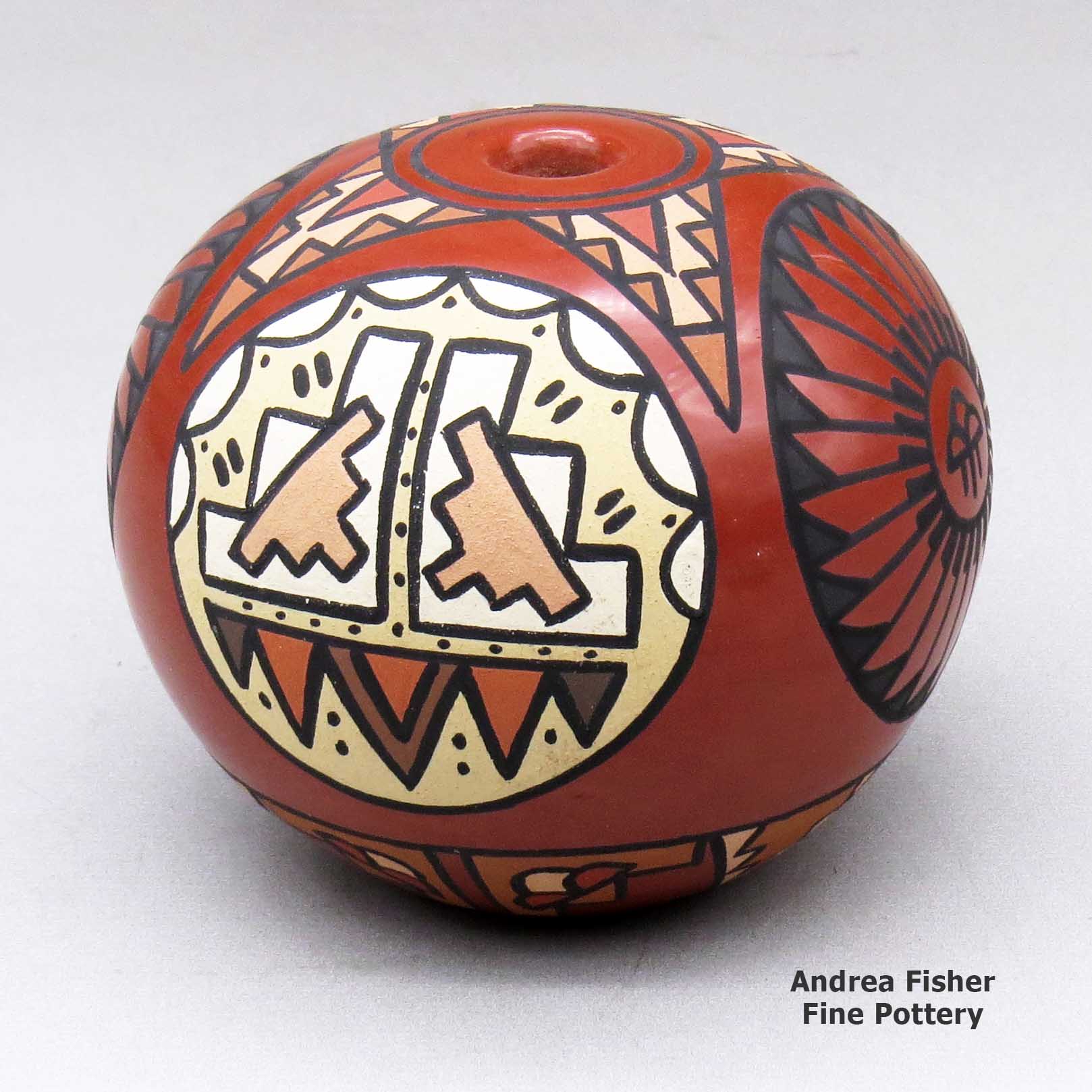
Minnie Vigil, Santa_Clara, Apolychromeseedpotdecoratedwithafour-panelmedallion-with-feathersandmedallionwithcloudandmountaingeometricdesigns
Santa Clara
$ 250
shsc4f318
A polychrome seed pot decorated with a four-panel medallion-with-feathers and medallion with cloud and mountain geometric designs
3.75 in L by 3.75 in W by 3 in H
Condition: Very Good
Signature: Minnie Santa Clara
100 West San Francisco Street, Santa Fe, New Mexico 87501
(505) 986-1234 - www.andreafisherpottery.com - All Rights Reserved

Seed Pots
Acoma, Hopi, Isleta, Jemez, Laguna, San Felipe, San Ildefonso, San Juan, Santa Clara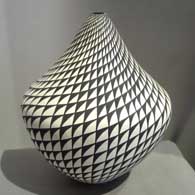
Acoma Pueblo
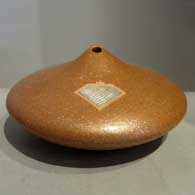
Hopi
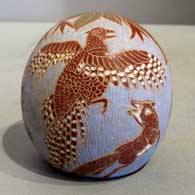
Santa Clara Pueblo
It was a matter of survival to the ancient Native American people that seeds be stored properly until the next planting season. Small, hollow pots were made to ensure that the precious seeds would be kept safe from moisture, light and rodents. After seeds were put into the pot, the small hole in the pot was plugged. The following spring the plug was removed and the seeds were shaken from the pot directly onto the planting area.
Today, seed pots are no longer necessary due to readily available seeds from commercial suppliers. However, seed pots continue to be made as beautiful, decorative works of art. The sizes and shapes of seed pots have evolved and vary greatly, depending on the vision of Clay Mother as seen through the artist. The decorations vary, too, from simple white seed pots with raised relief to multi-colored painted, raised relief and sgraffito designs, sometimes with inlaid gemstones and silver lids.
100 West San Francisco Street, Santa Fe, New Mexico 87501
(505) 986-1234 - www.andreafisherpottery.com - All Rights Reserved

Pasqualita Tani Gutierrez Family Tree
Disclaimer: This "family tree" is a best effort on our part to determine who the potters are in this family and arrange them in a generational order. The general information available is questionable so we have tried to show each of these diagrams to living members of each family to get their input and approval, too. This diagram is subject to change should we get better info.
Pasqualita Tani Gutierrez was the sister of Sarafina Tafoya.
- Pasqualita Tani Gutierrez (1883-) & Severiano Tafoya
- Petra Montoya (Pojoaque)(1907-1992) & Juan Isidro Gutierrez (Santa Clara, 1901-1977)
- Gloria Goldenrod Garcia & John Garcia
- Jason Okuu Pin Garcia
- Desiderio Star Gutierrez & Genevieve Tafoya
- Debra Duwyenie & Preston Duwyenie (Hopi)
- Lois Gutierrez (1948-) & Derek de la Cruz
- Juan de la Cruz
- Thelma (1946-) & Joe (1940-) Talachy (San Juan)
- Maria Minnie Vigil (1931-)
- Annette Vigil
- Virginia Gutierrez (daughter-in-law of Petra, Nambe/Pojoaque)(1940-2012)
- Gloria Goldenrod Garcia & John Garcia
- Tomacita Gutierrez Tafoya (1896-1977) & Cruz Tafoya (1889-1938)
- Cresencia Tafoya (1918-1999)
- Annie Baca (1941-)
- Pauline Martinez (1950-) & George Martinez (San Ildefonso) (1943-)
- Harriet Tafoya (1949-) & Elmer Red Starr (Sioux) (1937-)
- Ivan Red Starr (1969-1991)
- Norman Red Star (nephew) (1955-)
- Cresencia Tafoya (1918-1999)
- Celestina Naranjo & Salvador Naranjo
- Maria Barbarita Naranjo & José Dolores Naranjo
- Veronica Naranjo
Some of the above info is drawn from Pueblo Indian Pottery, 750 Artist Biographies, by Gregory Schaaf, © 2000, Center for Indigenous Arts & Studies. Other info is derived from personal contacts with family members and through interminable searches of the Internet.
(505) 986-1234 - www.andreafisherpottery.com - All Rights Reserved



